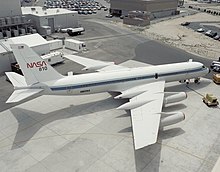Consolidated / Convair
Convair 990 Coronado
Role Narrow-body jet airliner
National origin United States
Manufacturer Convair
First flight January 24, 1961
Introduction 1962
Retired September 1987
(1994 with NASA)
Status Retired
Primary users American Airlines
Spantax
Swissair
Produced 1961–1963
Number built 37
Developed from Convair 880
.
History Consolidated / Convair
Convair 990 Coronado

The Convair 990 Coronado is an American narrow-body four-engined jet airliner produced between 1961 and 1963 by the Convair division of American company General Dynamics. It was a stretched version of its earlier Convair 880 produced in response to a request from American Airlines: the 990 was lengthened by 10 ft (3.0 m), which increased the number of passengers from between 88 and 110 in the 880 to between 96 and 121. This was still fewer passengers than the contemporary Boeing 707 (110 to 189) or Douglas DC-8 (105 to 173), although the 990 was 25–35 mph (40–56 km/h) faster than either in cruise.
American Airlines asked Convair to design an aircraft for coast-to-coast flights, able to fly nonstop from New York City to Los Angeles against the wind. They wanted a larger passenger capacity than the 880, which was the smallest of the first-generation U.S. jet airliners. It was known as the Convair 600 and was redesignated the Convair 990 in the month of its first flight. The 990 began flight testing on January 24, 1961. One change from the 880 was the large anti-shock bodies on the upper trailing edge of the wings, to increase the critical Mach by reducing transonic drag. The inboard shock bodies, which were larger, were also used for additional fuel tankage. Later during the design period, Convair modified the design to include fuel in the outboard pods as well, but during the initial test flights the extra weight caused the outboard engines to oscillate in certain conditions. The pods were redesigned once more and shortened by 28 inches (710 mm), causing increased drag. The inner set of pods were used to route the fuel-dump tubes from the fuel tanks, terminating in a prominent outlet
Operators


- Aerolíneas Peruanas S.A.* - Aerolineas Peruanas operated two Convair 990As from Callao International Airport, Lima.[14]
- Air Afrique
- Air Ceylon
- Air France (one aircraft leased in 1967)
- Alaska Airlines
- American Airlines*
- Aerovías Ecuatorianas
- Balair (leased from Swissair)
- Ciskei International Airways- no revenue flights made
- Christ is the Answer (leased from Galaxy Airlines)- no revenue flights made
- Denver Ports of Call
- El Al Israel Airlines
- Galaxy Airlines
- Garuda Indonesian Airways*
- Ghana Airways (leased from Swissair)
- Iberia Líneas Aéreas de España (leased from Spantax)
0
KmCeiling
0
KmCombat RANGE
0
Km/hAircraft Speed
0
Max Crew
Photo Gallery
Consolidated / Convair / Vultee
Convair 990 Coronado


Consolidated Convair Vultee
Convair 990 Coronado
General characteristics
- Crew: 4 (+ cabin crew)
- Capacity: up to 149 passengers
- Length: 139 ft 9 in (42.60 m)
- Wingspan: 120 ft (37 m)
- Height: 39 ft 6 in (12.04 m)
- Wing area: 2,250 sq ft (209 m2)
Powerplant
- Empty weight: 133,000 lb (60,328 kg)
- Maximum zero-fuel weight: 160,000 lb (72,575 kg)
- Max takeoff weight: 253,000 lb (114,759 kg)
- Maximum landing weight: 202,000 lb (91,626 kg)
- Powerplant: 4 × General Electric CJ805-23B turbofan engines, 16,050 lbf (71.4 kN) thrust each aft=fan engines
Specifications
- Maximum speed: 540 kn (620 mph, 1,000 km/h) at 20,000 ft (6,096 m) at 200,000 lb (90,718 kg) AUW
- Maximum speed: Mach 0.871
- Cruise speed: 484 kn (557 mph, 896 km/h) / M0.84 at 35,000 ft (10,668 m)
- Range: 3,302 nmi (3,800 mi, 6,115 km) with 104,373 lb (47,343 kg) usable fuel, 25,770 lb (11,689 kg) payload and 18,000 lb (8,165 kg) reserve fuel
- Service ceiling: 41,000 ft (12,000 m)
- Take-off run: 9,800 ft (2,987 m) at MTOW (SR-422B Field length)
- Landing run: 5,400 ft (1,646 m) at 170,000 lb (77,111 kg) AUW (SR-422B Field length)
.
Links to Youtube & Others
The "Camel" may be regarded as the prototype of the Consolidated response to the USAAS's 1924 requirement for a new primary trainer. In the early summer of 1924.
Convair 990 Coronado
When the major airlines retired their Convair 990s, they found a second life on charter airlines. Spantax of Spain had a large fleet until the mid-1980s, as did Denver Ports of Cal
Youtube Link
The 990 did not meet the specifications promised, and American Airlines reduced its order as a result.












